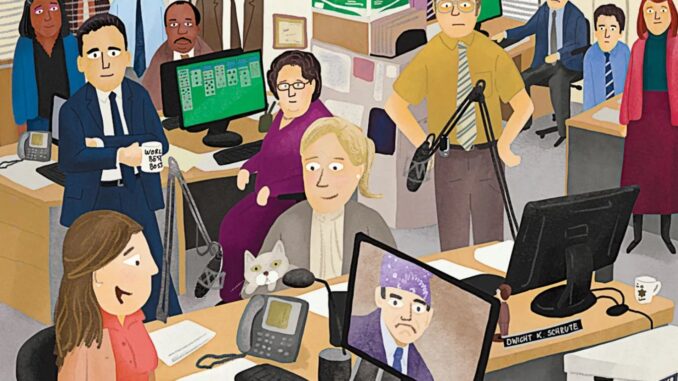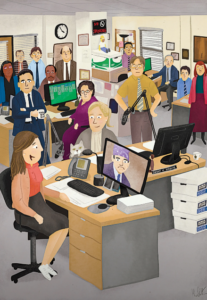
Why Do We Still Love “The Office”?

Until this spring, a dominant part of the human experience involved leaving one’s home, going somewhere else, encountering a specific bunch of people, trying to get along with them, doing some work, bidding them goodbye, and going home again. The comedy of this ritual—disparate characters flung together day after day, attempting to accomplish grand or humble things without killing one another—has fuelled countless workplace sitcoms, from “The Mary Tyler Moore Show” to “30 Rock.” But “The Office,” the American faux-documentary series that ran from 2005 to 2013, and which arose from the sour, drab-looking, painfully funny British sitcom of the same name, came to be one of our most prominent depictions of office life, because it seemed to show us the truth in the tedium. As Jim (John Krasinski), the show’s Everyman character, who finds love with Pam (Jenna Fischer), the receptionist, says, “Everything I have I owe to this job—this stupid, wonderful, boring, amazing job.”
Is the office good for us? The answer to that question changes during the long trajectory of the series. The British “Office,” created by Ricky Gervais and Stephen Merchant, which began in 2001 and comprises fourteen episodes, was inspired in part by a reality-TV trend popular in the U.K. at the time, depicting regular people doing regular things, such as attending driving school. It was set at a middling place in a middling town: a branch of the Wernham Hogg paper company, in Slough. The boss, David Brent (Gervais), was a jokey, goateed nightmare wrapped in neediness and a necktie (“I’m a friend first and a boss second, probably an entertainer third”), and everybody else, his captive audience, was vaguely depressed and numb, getting by on paychecks, crushes, and pranks. The actors looked and acted like everyday people—almost startlingly so. Yet the show’s bleak world quickly became addictive, and its brief opening sequence—sweeping instrumental theme, mid-rise office buildings, cars swirling through a roundabout—can still provoke an aching wistfulness, for Wernham Hogg and, somehow, for the day-to-day life you’re actually living.
The American adaptation, created by Greg Daniels (“King of the Hill”) with Gervais and Merchant, supersized all this—some two hundred episodes, extensive world-building, more romance—and placed its middling paper company, Dunder Mifflin, in working-class Scranton, Pennsylvania. Viewer wistfulness has only increased with time. Though it ended seven years ago, the American “Office” competes, even now, to be the most-watched show on Netflix. More than forty-six billion minutes of it were streamed in 2018. The teen pop star Billie Eilish, whose song “My Strange Addiction” samples “Office” dialogue, has seen the entire series fourteen times. And this year two of the most popular podcasts on iTunes and Spotify were “Office” podcasts, hosted by former cast members.
Both podcasts accept the show’s genius and significance as a given. “An Oral History of ‘The Office,’ ” a limited series with Brian Baumgartner, who played Kevin the accountant, aims to find out “how a group of unknowns overcame the odds and changed the face of television,” and recently concluded on Spotify; “Office Ladies,” “the ultimate ‘Office’ rewatch podcast,” hosted by Angela Kinsey (Angela) and Jenna Fischer, discusses each episode in order, and may go on forever. “We were on ‘The Office’ together!” Fischer says in the intro. Kinsey adds, “And—we’re best friends!” It’s a chipper gabfest. Fischer begins episodes with “Fast Facts”; Kinsey, who enjoys using “shiitake” as a swear, describes details she observes upon rewatching, such as Kelly Kapoor’s updo. The insight to be found is roughly proportional to the amount of work that gets done at Dunder Mifflin: enough, but it’s not really the point.
Baumgartner’s show is almost as giddy—the word “brilliant” is thrown around generously—but it accomplishes the useful service of making the familiar unfamiliar again. It can be easy to forget how strange the American “Office” was on prime-time television in 2005—and how unlikely it was to succeed. “O.K., here’s the pitch,” the executive producer, Ben Silverman, says, laughing, in Baumgartner’s first episode. “Unlikable lead, single camera, no one really attractive in a traditional television sense. Super awkward and slow, no laugh track, and a faux documentary.” The format was not only technically challenging—and unappealing to network execs—but hard for American audiences to comprehend; it wasn’t yet a sitcom trope in the U.S., and reality TV itself had yet to boom. The setting was mundane. And the creators wanted actors who were realistic-looking, just like the British cast.
